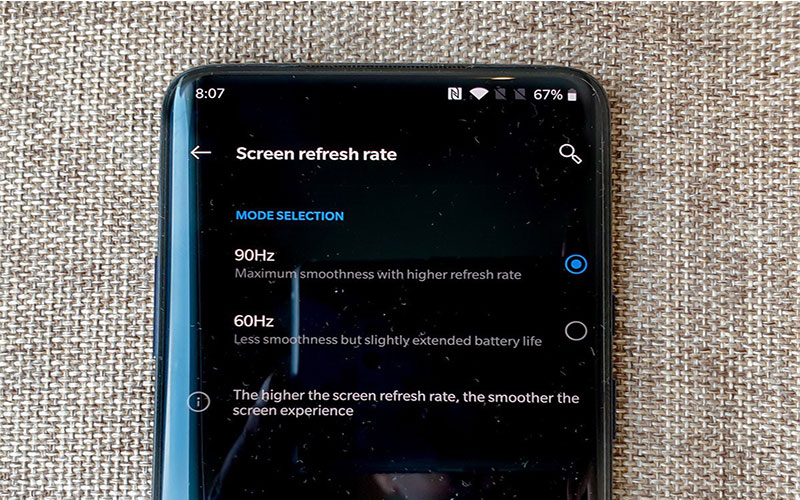Before handling the product to its customer’s many comprehensive tests are conducted like security tests, customer feasibility tests, and functional tests, etc. These tests are conducted to ensure the satisfaction of its users. Like other parameters, the screen refresh rate also matters. Variation in refresh rate affects the smoothness of the delivered visuals.
The phone screen refresh rate is the measure of display update per second. The more the screen refreshes, the smoother the image will be. The refresh rate is usually measured in Hertz (Hz). The phone screen refresh rate is different from the touch response rate which is the rate at which our phone screen senses input from our finger per second. The most common refresh rates are 60Hz, 75Hz, 144Hz, and 240 Hz.
As the touch response rate is different from the phone screen refresh rate, in the same way it is also different to frame rate per second. Frame rate per second defines the speed at which the consecutive images (frames) are displayed per second. It is abbreviated as FPS. In other words, FPS refers to the images that the graphing unit is processing per second which varies relying on its intensity whereas screen refresh rate refers to the ability the screen (not graphing unit) has to display those images per second.
Before talking about whether a higher or lower refresh rate is best for your screen let’s first look into the characteristics of all types of screen refresh rate in detail.
60Hz VS 90Hz VS 120Hz
A 60 Hz means the visual display can reimage on screen 60 times per second. A vast majority of the phone comes with a 60Hz refresh rate. It is widely accepted as a standard screen refresh rate because of its smoothness. However, we are not able to see these refresh rates on our screens as human vision does not have properties like resolution, frame rate, and screen refresh rate because of the movement of the human eye, head, and body. As the screen refresh rate increases, the quality of display also improves thus it means the phone with a 90Hz refresh rate will have better performance and smoother image and video.
Similarly, smartphones with 90Hz or 120Hz display refresh 90 and 120 times relatively per second gives you a smoother experience.
Benefits of higher refresh rate
Improvements in gadgets are done to upgrade the level of satisfaction of the users. The screen refresh rate has been improved and still improving; 60Hz to 75Hz, 75Hz to 90Hz, 90Hz to 120Hz, and 120Hz to 144Hz. Indeed these improvements do have some benefits:
- Respond faster
- Smoother visuals
- Smoother motion
- Smoother video
- Better performance in gaming
- Improved media quality
- Reduced motion blur in text and graphics
- Smoother scrolling experience
- Easier on eyes
- Enhances smartphone experience
Downsides of higher refresh rates
Although high refresh rate is the latest battle for android manufacturers as it has improved overall visual experience but it does have some downsides as:
- Requires more processing power thus drain more battery
- More suitable to game lover viewers
How to check the phone screen refresh rate test?
To check the test follow the following step:
- Open Play store.
- Search AIDA64
- Install
- Open
- Go to display
- Your screen rate will be visible on the screen
| Phones with screen refresh rates | ||
| 60Hz | 90Hz | 120Hz |
| OPPO F17 pro | Huawei P40 pro | Samsung Galaxy S20 |
| TECNO Spark 6 Air | Honor X 105G | Samsung Galaxy S20+ |
| Honor30 Pro+ | Samsung Galaxy S20 ultra | |
| Oppo Reno 4 Pro 5G | Samsung Galaxy Note 20 ultra | |
| Oppo Ace2 | Samsung Galaxy S20FE | |
| Oppo A72 5G | iPhone11 Pro | |
| iPhone11 Pro Max | ||
Better screen refresh rate and gaming
Gamers require gamers to react promptly and to dig out solutions immediately so gamers want their every component of their game to be perfect. Regarding better and improved screen refresh rates it makes the display smoother and sharper. A few years back higher screen refresh rates were only associated with the PC’s but evolving technology is providing smartphones with better and high screen refresh rates. Samsung s series, iPhone 11, iPhone 11 Pro are now available in the market with a screen refresh rate of 120 Hz. One thing should be kept in mind that this high screen refresh rate will ultimately cause low increased battery usage.

